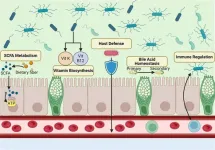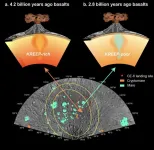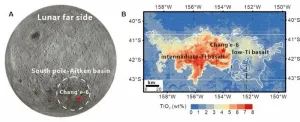(Press-News.org) FROM: James Urton
University of Washington
206-543-2580
jurton@uw.edu
(Note: researcher contact information at the end)
Hunted nearly to extinction during 20th century whaling, the Antarctic blue whale, the world’s largest animal, went from a population size of roughly 200,000 to little more than 300. The most recent estimate in 2004 put Antarctic blue whales at less than 1% of their pre-whaling levels.
But is this population recovering? Is there just one population of Antarctic blue whales, or multiple? Do these questions matter for conservation?
A team led by Zoe Rand, a University of Washington doctoral student, tackles these questions in a study, published Nov. 14 in Endangered Species Research. Building on the last assessment of Antarctic blue whales in 2004 and using old whaling records, which were surprisingly detailed, Rand and her colleagues investigated if the Antarctic blue whales consist of different populations or are one big circumpolar population. Study co-authors are Trevor Branch, a UW professor of aquatic and fishery sciences, and Jennifer Jackson from the British Antarctic Survey.
Antarctic blue whales are listed as an endangered species, and understanding their population structure is essential for their conservation. Conservation at the population-level increases biodiversity, which helps the species adapt better to environmental changes and increases chances of long-term survival.
During the whaling years, biologists began the Discovery Marking Program. Foot-long metal rods with serial numbers were shot into the muscles of whales. When these whales were caught, the metal rod was returned, and the whale’s size, sex, length and location where it was caught was noted. Looking at where whales were marked compared to where they were caught could shed valuable insight into the movement of Antarctic blue whales, but these data have never been used before to look at population structure.
In this new study, this historical data were used alongside contemporary survey data in Bayesian models to calculate inter-annual movement rates among the three ocean basins that make up the Southern Ocean — Atlantic, Indian and Pacific — which make up the feeding grounds for Antarctic blue whales. The team found frequent mixing among the ocean basins, suggesting that whales do not return to the same basin every year. This points to Antarctic blue whales being one single circumpolar population in the Southern Ocean.
These results are consistent with studies of Antarctic blue whale songs, heard throughout the Southern Ocean. Only one song type has been recorded among the Antarctic blue whales. In comparison, pygmy blue whales have five different songs corresponding to five different populations. These results are also consistent with genetic studies, which found that Antarctic blue whales are more closely related than would be expected if they were separate populations.
This study is the first time that historical mark-recovery data from the Discovery Marking Program has been analyzed using modern quantitative methods. These data exist for many other hunted whale species, such as fin and sei whales, so the new study’s methods could provide a framework for similar analyses for those whale species too.
There is still a lot scientists don’t know about the Antarctic blue whale. Even though they do not appear to be separated geographically on their feeding waters in different ocean basins, they could still have distinct population structures based on differences in breeding habitats or the timing of migration. However, almost nothing is known about Antarctic blue whale breeding behavior, according to the researchers. Using historical data from whaling alongside contemporary data — such as satellite tagging and photo-identification — remains scientists’ best hope for uncovering the secrets of the largest animal on Earth.
The research was funded by the International Whaling Commission’s Southern Ocean Research Partnership.
###
For more information, contact Rand at zrand@uw.edu and Branch at tbranch@uw.edu.
Text by Niamh Owen-McLaughlin.
END
A group of South Korean researchers has decided to utilize AI technology to support customer counseling services. Through this, it will provide a significant boost to the performance and efficiency of counselors in various industries, while improving the overall quality of customer counseling services, ultimately making it easier to meet the customers’ needs and expectations while opening up the possibility for realizing new values.
Electronics and Telecommunications Research Institute (ETRI) announced that ...
The gut microbiome, an ecosystem of trillions of microorganisms in the human digestive tract, has been increasingly linked to chronic diseases. Research led by Dr. Connor Prosty and his team at McGill University consolidates recent findings that demonstrate a causal role for the gut microbiome in the progression of multiple diseases, ranging from gastrointestinal conditions to immune-related and psychiatric disorders. Published in eGastroenterology, this narrative review examines how manipulating the gut microbiome ...
Family Heart Foundation Appoints Dr. Seth Baum as Chairman of the Board of Directors
Dr. Seth Baum, Florida Atlantic University, Named Chairman of the Family Heart Foundation’s Board of Directors
The Family Heart Foundation® is proud to announce the appointment of Dr. Seth Baum as the Board of Directors Chairman. An esteemed expert in preventive cardiology and lipidology, Dr. Baum has insights and extensive experience that will contribute to the Foundation’s strategic mission to increase awareness for lay public, expand screening for high-risk populations, improve understanding and education for healthcare teams, and promote ...
A new route to materials with complex ‘disordered’ magnetic properties at the quantum level has been produced by scientists for the first time.
The material, based on a framework of ruthenium, fulfils the requirements of the ‘Kitaev quantum spin liquid state’ - an elusive phenomenon that scientists have been trying to understand for decades.
Published in Nature Communications the study, by scientists at the University of Birmingham, offers an important step towards achieving and controlling quantum materials with sought-after new properties that do not follow ...
Basalt samples returned by the Chang’e-6 mission have revealed volcanic events on the lunar farside at 2.8 billion years ago (Ga) and 4.2 Ga, according to research conducted by Prof. LI Qiuli’s lab at the Institute of Geology and Geophysics of the Chinese Academy of Sciences. This work was recently published in Nature.
“Unraveling the volcanic history of the lunar farside is crucial for understanding the hemispheric dichotomy of the Moon,” said Prof. LI.
The asymmetry between the Moon’s nearside and farside—encompassing differences in basalt distribution, topography, crustal thickness, and thorium ...
The Moon has a global dichotomy, with its near and far sides having different geomorphology, topography, chemical composition, crustal thickness, and evidence of volcanism.
To better understand this dichotomy, Professor XU Yigang’s team from the Guangzhou Institute of Geochemistry of the Chinese Academy of Sciences investigated lunar soil samples from the far side South Pole-Aitken (SPA) Basin of the Moon returned by the Chang’e-6 mission.
Their work was published in Science on Nov. 15.
“The samples returned by Chang’e-6 provide a best opportunity to investigate the lunar global dichotomy,” said Professor ...
Dietary zinc deficiency promotes lung infection by Acinetobacter baumannii bacteria — a leading cause of ventilator-associated pneumonia, according to a new study published Nov. 15 in the journal Nature Microbiology.
A Vanderbilt University Medical Center-led team of researchers discovered an unexpected link between the pro-inflammatory cytokine interleukin-13 (IL-13) and A. baumannii lung infection, and they demonstrated that blocking IL-13 prevented infection-associated death in an animal model.
The findings suggest that anti-IL-13 antibodies, which are FDA-approved for use in humans, may protect against bacterial pneumonia in patients with zinc deficiency.
“To ...
In what could one day become a new treatment for epilepsy, researchers at UC San Francisco, UC Santa Cruz and UC Berkeley have used pulses of light to prevent seizure-like activity in neurons.
The researchers used brain tissue that had been removed from epilepsy patients as part of their treatment.
Eventually, they hope the technique will replace surgery to remove the brain tissue where seizures originate, providing a less invasive option for patients whose symptoms cannot be controlled with medication.
The ...
Children born to mothers who take antiseizure medications to manage seizures and psychiatric conditions during pregnancy may face increased risks of neurodevelopmental conditions, according to new data from researchers at Drexel’s Dornsife School of Public Health.
The current work -- using data from more than three million children from the United Kingdom and Sweden, including 17,495 who were exposed to antiseizure medications during pregnancy -- found that children exposed to the antiseizure drug lamotrigine ...
Bottom Line: In patients with unresectable, locally advanced esophageal cancer, the triple combination of radiation, chemotherapy, and immunotherapy made tumors more amenable to surgery, which was associated with significantly improved outcomes.
Journal in Which the Study was Published: Clinical Cancer Research, a journal of the American Association for Cancer Research.
Background: “Curative resection unequivocally serves as the cornerstone for treating resectable esophageal squamous cell carcinoma (ESCC); ...




